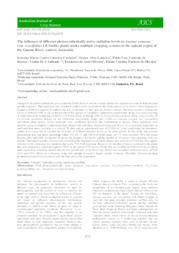The influence of different photosynthetically active radiation levels on Ananas comosus (var. erectifolius LB Smith) plant sunder multiple cropping systems in the upland region of the Guama River, eastern Amazonia.
The influence of different photosynthetically active radiation levels on Ananas comosus (var. erectifolius LB Smith) plant sunder multiple cropping systems in the upland region of the Guama River, eastern Amazonia.
Author(s): CORDEIRO, I. M. C. C.; LAMEIRA, O. A.; BARROS, P. L. C. de; ANDRADE, V. M. S.; ILIVEIRA, F. de A.; OLIVEIRA, E. C. P. de
Summary: Changes in the photosynthetically active radiation (PAR) levels to which a certain species are adapted can result in different plant growth responses. Thus, analytical and systematic studies on the mechanisms that plant species use to survive when subjected to changes in PAR are required. To address the lack of literature on this topic for Ananas comosus, this study aimed to evaluate the effects of different PAR levels on the growth of this species. A completely randomised experimental design was used consisting of subdivided plots containing a total of 1176 forest plants, including 1040 Sc (Schizolobium parahyba subsp. amazonicum), 96 Cg (Cordia goeldiana Huber), 40 Sw (Swietenia macrophylla King), and 13.000 An (Ananas comosus var. erectifolius) agricultural plant species. Seven treatments were established based on this combination of species. These treatments were installed using a completely randomised block design with split plots. Each plot measured 18 m x 24 m, and each treatment was replicated four times, resulting in a total of 28 plots and an experimental area of 12.096 m². After establishing the treatments, studies were conducted to evaluate the influence of different radiation levels on An plant growth. In this study, pluviometric precipitation data and mean percentage values (53, 64, 71 and 100%) of PAR (?mol m-² s-1) were recorded. Over the period between 2003 and 2006, the number of leaves, the lengths of the leaves, and the number of An sprouts were measured every six months. The highest number of leaves was recorded in the treatments in which the plants were exposed to 64% PAR. The number of leaves in this treatment was similar to that in the 71% PAR treatment. However, the number of leaves decreased in the plants that were subjected to either the highest (100%) or the lowest (53%) level of PAR. The use of different PAR levels for An plants under cultivation conditions showed that the best growth rates of the leaves and shoots were associated with lower levels of PAR (53% and 64%). However, cultivation under full sunlight favoured a higher number of leaves. The fibre, leaf and mucilage production progressively increased until the third year of the experiment.
Publication year: 2016
Types of publication: Journal article
Unit: Embrapa Eastern Amazon
Observation
Some of Embrapa's publications are published as ePub files. To read them, use or download one of the following free software options to your computer or mobile device. Android: Google Play Books; IOS: iBooks; Windows and Linux: Calibre.
Access other publications
Access the Agricultural Research Database (BDPA) to consult Embrapa's full library collection and records.
Visit Embrapa Bookstore to purchase books and other publications sold by Embrapa.

